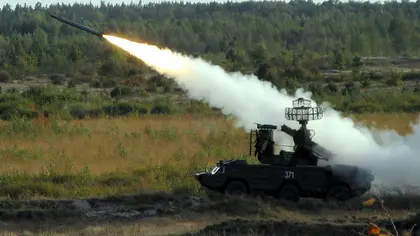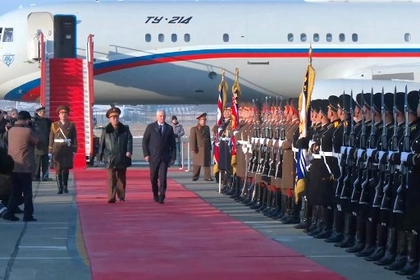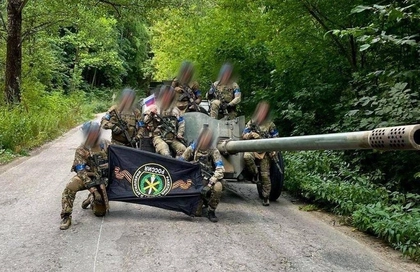On Friday, the Russian Air Force reportedly lost its fifth attack jet in ten days, in a combat aircraft loss spike not seen in Moscow’s combat air operations over Ukraine since the first days of the war.
Russian aviators aboard Su-25 Grach aircraft (NATO: Frogfoot), an armored Soviet-era jet designed to resist small arms fire and even some missile strikes, were knocked down by Ukrainian anti-aircraft weapons fired in Ukraine’s eastern Donetsk region and southern Zaporizhzhia regions, Ukrainian official military sources said.
JOIN US ON TELEGRAM
Follow our coverage of the war on the @Kyivpost_official.
Independent Ukrainian military information channels and mainstream Ukrainian media widely confirmed the shootdowns, citing Ukrainian Air Force sources.
“The enemy has to fly closer, so we’ve shot down five planes over the past ten days.”
Oleksandr Shtupun, spokesperson for Ukraine’s joint forces south, told the UNIAN news agency that intensifying Russian operation of sub-sonic Su-25s close to front lines in support of Kremlin ground troop assaults has increasingly brought the single-seat aircraft into the range of shorter-ranged Ukrainian ground-based air defense systems that are able to shoot them down.
“They (Su-25s) can’t attack from a substantial distance. Therefore, the enemy has to fly closer, and as a result, we’ve shot down five planes over the past ten days,” Shtupun said.
All the shootdowns took place in sectors of heavy ground combat. In recent weeks, the Russian Air Force intensified ground strikes against Ukrainian defenses using new supplies of long-range glider bombs.

What if Russia Wins?
In early October, the winged munitions launched primarily from Russian heavy Su-24 bombers from outside the range of Ukrainian front-line air defense weapons.
By Russian Air Force doctrine and wartime practice, the Su-25 operates at extremely low altitudes and attacks targets using short-range unguided rockets, following preliminary strikes by heavy bombers. Video of low-level passes by Su-25s, and the pilots at the controls, are a regular feature of pro-Russian information platforms.
Shtupun and other official Ukrainian military sources offered few details on the air defense systems used by Kyiv forces now, but according to official claims, they’re knocking Su-25s out of the air at a pace of one aircraft every 48 hours.
In the past the Ukrainian military has depended primarily on Cold War-era hand-held anti-aircraft missiles, like the Polish Grom and the US Stinger, to defend its forward positions from Su-25 strikes.
However, according to widespread news reports, anti-aircraft missile stocks, particularly of the America-donated Stinger, have run low.
Ukrainian Air Force spokesman Yury Ihnat, in September comments to local media, said that the Russian Air Force sortie rate by summer 2023 had more than doubled sortie rates in 2022, in part because of chronic shortages of short-range, ground-launched, anti-aircraft missiles available to Kyiv’s forces.
The Ukrainian military information platform Defense Express, in a Sept. 30 report, suggested Ukrainian land forces were being beefed up with US-delivered AIM-9 air-to-air missiles – modified to be fired from a ground platform.
At an Oct. 14 Ramstein meeting US Defense Secretary Lloyd Austin confirmed that part of the latest American military assistance package to Ukraine, valued at $200 million, would include new deliveries of the AIM-9.
Austin said the missile would be used for a new air defense system “which we will hand over to Ukraine in the near future.”
SEE ALSO: Russian Air Force Grapples With Worst. Week. Of. The. War.
According to the magazine report, the Pentagon plan calls for a later version of the missile, the AIM-9M, to be fired from a to-be-named Ukrainian vehicle rigged to shoot it.
The AIM-9 Sidewinder, named for a heat-sensing rattlesnake that can “see” prey in the infrared spectrum, is a heat-seeking missile developed in the mid-Cold War and effective at short ranges.
The US first announced plans to send Sidewinders to Ukraine in April, along with Canada, which also has fielded the missile for decades. At the time, news reports said the Sidewinders were probably destined for use by Ukrainian Air Force fighter jets.
The Defense Express article said the Armed Forces of Ukraine (AFU) are currently experimenting with ways to retrofit Soviet-era anti-aircraft systems in AFU inventory with a tracking radar and optics enabling weapon operators to spot a Russian combat aircraft in the sky and engage with a Sidewinder.
Soviet-era Osa missile launchers (NATO designator SA-8 Gecko) currently in the Ukrainian military inventory is the prime candidate for the reconfiguration to AIM-9 because Kyiv’s stocks of SA-8 missiles are exhausted and gunners are trained in operating the vehicle, but the AFU is considering other platforms, the report said.
Major American media confirmed the ground-launched AIM-9 for Ukraine initiative was moving. The news agency AP on Oct. 14 said the “FrankenSAM… project is gaining momentum.”
Fired from the ground, the jury-rigged AIM-9 ground firing system, once fielded, would give Ukrainian forces the ability to shut down most air space around a launcher to a distance of between five kilometers and ten kilometers. Critically for the AFU, the veteran missile would have a good chance of hitting and destroying non-stealth aircraft flying close to the ground, like the Su-25.
The AP article said Ukrainian artificers working with Pentagon representatives already have modified a heavier Soviet-era missile launcher, called by the Ukrainian (and Russian) military “Buk” (NATO designator SA-6 Gainful) to fire the American RIM-7 anti-aircraft missile, a weapon primarily used by the US Navy for short-range ship defense.
According to Ukrainian news reports, a Buk firing a RIM-7 is effective out to a range of about 15 km, but because the Soviet-era tracking radar on the Buk doesn’t link with the American RIM-7, the missile is less accurate than if fired off a US warship.
The SA-6 missile’s range is at least double the RIM-7’s, but Ukraine doesn’t manufacture the SA-6 and supplies are near the bottom, those reports say.
It’s not clear how many Ukrainian Buk systems have been retrofitted to fire RIM-7 missiles.
A third confirmed anti-aircraft system of mixed origins confirmed on Ukrainian battlefields is a British missile called AIM-132 ASRAAM, a fully modern weapon and a direct update of the Cold War-era AIM-9.
For the United Kingdom, the AIM-132 is primarily a short-range, air-to-air weapon carried by front-line fighters.
Ukraine in August took delivery of a batch of London-donated AIM-132 missiles which, for the first time on Oct. 12, were shown by the Ukrainian military to be in action as a ground weapon engaging a Russian kamikaze drone.
The missile was fired from a British army 6x6 Supacat truck, killing the drone in an Oct. 6 engagement, news reports said.
All three Western short-range missiles known to operate by the AFU in “FrankenSAM” mode are fully capable of knocking down a Su-25 jet. Deployment locations of Ukrainian air defense systems is a military secret.
The worst Russian Air Force losses took place at the outset of Moscow’s invasion of Ukraine on Feb. 24, 2022, with massive helicopter and paratrooper assaults, backed by ground attack and fighter aircraft, assaulting a pair of airfields near the Ukrainian capital of Kyiv.
Open sources confirm Ukraine air defenses destroyed at least six Russian combat jets and eight helicopters in the first five days of fighting. Ukrainian army kill claims are 50 percent higher.
You can also highlight the text and press Ctrl + Enter






